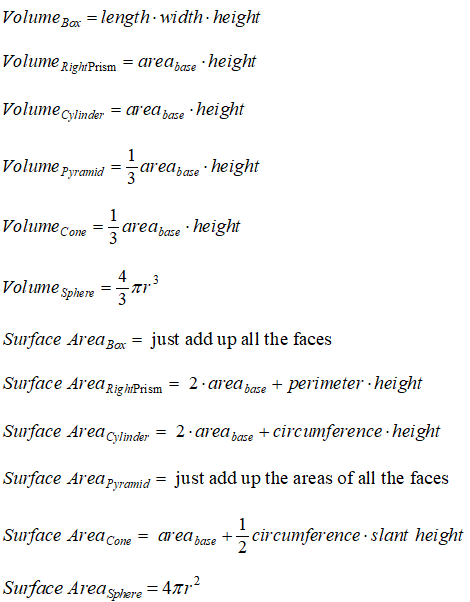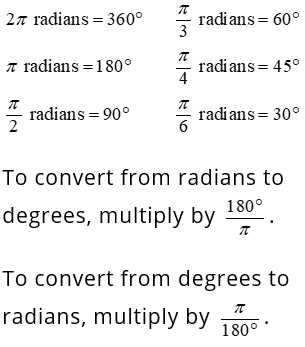Some Essential Algebra
Algebra is the language of calculus. You can’t do calculus without the following basic rules you learned in Algebra I or Algebra II. At a minimum, you need to be on top of the topics covered here: powers, roots, logs, factoring, the quadratic formula, and lines (including slope, one of the most important ideas used in calculus).
Power rules

Root rules

Log rules

Factoring patterns

Quadratic formula

Algebra for lines

Some Important Geometry Formulas
Formulas for triangles

Formulas for other two-dimensional shapes

Formulas for three-dimensional shapes

Coordinate geometry formulas

Some Basic Trigonometry
Trig comes up in many calculus problems, so, if your trig is a bit rusty, you can refer to this handy list of basic trig concepts.
Right triangle trig
SohCahToa

Radians and degrees
 Identities
Identities
Reciprocal identities

Quotient identities

Pythagorean identities

Formulas
Half-angle formulas

Double-angle formulas

Reduction formulas

Limits
In your calculus class, you learn a few techniques for evaluating limits. Some of those techniques take a little doing. But for the basic limits on the list here, the best approach is to simply memorize them (or “cheat” by using this “sheet”).

Differentiation Rules
Here are 20 of the most frequently used differentiation rules. You may or may not need to memorize all 20 (depending on your teacher), but you will certainly want to memorize rules 1 to 6 and 9 to 11. (Note the way I’ve written the product and quotient rules. Your textbook may list these rules in a slightly different, though equivalent, way. I recommend memorizing them the way they’re written here, where both rules begin with the derivative of the first thing you read, namely, the u. That’s the easiest way to memorize these rules.)

Integration Rules
And here are 20 of the most frequently used integration rules. If you want to commit some of them to memory, I’d start with numbers 1, 2, 3, 4, 7, 8, 13, 14, 15, and 16. Next would be 17, 18, and 19.

Infinite Series: Convergence/Divergence Tests
Following are 10 tests for the convergence or divergence of an infinite series.
As a memory aid, you can group them as follows: there are three tests for series with names (geometric series, p-series, and telescoping series), three comparison tests (direct, limit, and integral), two “R” tests (ratio and root), and, finally, two tests that bookend the other eight (the nth term test and the alternating series test, which also involves the nth term).
The nth term test

Geometric series test

The p-series test

Telescoping series test

Direct comparison test

Limit comparison test

Integral comparison test

The ratio test

The root test

Alternating series test
An alternating series converges if two conditions are met:
- Its nth term converges to zero.
- Its terms are non-increasing — in other words, each term is less than or equal to its predecessor (ignoring the minus signs).
(Note that you are free to ignore any number of initial terms when checking whether condition 2 is satisfied.)






